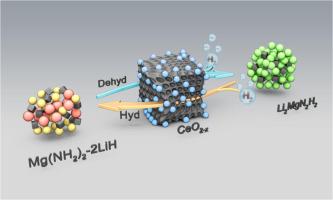Experimental and theoretical study on high hydrogen storage performance of Mg(NH2)2-2LiH composite system driven by nano CeO2 oxygen vacancies
IF 14.3
1区 材料科学
Q1 MATERIALS SCIENCE, MULTIDISCIPLINARY
引用次数: 0
Abstract
The magnesium based metal hydrogen storage composite system Mg(NH2)2-2LiH has a theoretical hydrogen storage capacity of 5.6 wt.% and is a promising hydrogen storage material for vehicles. However, its application is limited due to serious thermodynamic and kinetic barriers. Introducing efficient catalysts is an effective method to improve the hydrogen storage performance of Mg(NH2)2-2LiH. This article investigates for the first time the use of nano rare earth oxide CeO2 (∼44.5 nm) as an efficient modifier, achieving comprehensive regulation of the hydrogen storage performance of Mg(NH2)2-2LiH composite system through oxygen vacancy driven catalysis. The modification mechanism of nano CeO2 is also systematically studied using density functional theory (DFT) calculations and experimental results. Research has shown that the comprehensive hydrogen storage performance of the Mg(NH2)2-2LiH-5 wt.% CeO2 composite system is optimal, with high hydrogen absorption and desorption kinetics and reversible performance. The initial hydrogen absorption and desorption temperatures of the composite system were significantly reduced from 110/130°C to 65/80°C, and the release of by-product ammonia was significantly inhibited. Under the conditions of 170°C/50 min and 180°C/100 min, 4.37 wt.% of hydrogen can be rapidly absorbed and released. After 10 cycles of hydrogen release, the hydrogen cycle retention rate increased from 85% to nearly 100%. Further mechanistic studies have shown that the nano CeO2−x generated in situ during hydrogen evolution can effectively weaken the Mg–N and N–H bonds of Mg(NH2)2, exhibiting good catalytic effects. Meanwhile, oxygen vacancies provide a fast pathway for the diffusion of hydrogen atoms in the composite system. In addition, nano CeO2−x can effectively inhibit the polycrystalline transformation of the hydrogen evolving product Li2MgN2H2 in the system at high temperatures, reducing the difficulty of re-hydrogenation of the system. This study provides an innovative perspective for the efficient modification of magnesium based metal hydrogen storage composite materials using rare earth based catalysts, and also provides a reference for regulating the comprehensive hydrogen storage performance of hydrogen storage materials using rare earth catalysts with oxygen vacancies.

纳米 CeO2 氧空位驱动的 Mg(NH2)2-2LiH 复合体系高储氢性能的实验和理论研究
镁基金属储氢复合系统 Mg(NH2)2-2LiH 的理论储氢能力为 5.6 wt.%,是一种很有前途的汽车储氢材料。然而,由于存在严重的热力学和动力学障碍,其应用受到了限制。引入高效催化剂是提高 Mg(NH2)2-2LiH 储氢性能的有效方法。本文首次研究了利用纳米稀土氧化物 CeO2(∼44.5 nm)作为高效改性剂,通过氧空位催化实现对 Mg(NH2)2-2LiH 复合体系储氢性能的综合调控。此外,还利用密度泛函理论(DFT)计算和实验结果对纳米 CeO2 的改性机理进行了系统研究。研究表明,Mg(NH2)2-2LiH-5 wt.% CeO2 复合体系的储氢综合性能最佳,具有较高的吸氢、解吸动力学和可逆性能。复合体系的初始吸氢和解吸温度从 110/130°C 显著降低到 65/80°C,副产物氨的释放也受到明显抑制。在 170°C/50 分钟和 180°C/100 分钟的条件下,可快速吸收和释放 4.37 重量百分比的氢气。经过 10 次循环释放氢气后,氢气循环保留率从 85% 提高到接近 100%。进一步的机理研究表明,氢演化过程中原位生成的纳米 CeO2-x 能有效削弱 Mg(NH2)2 的 Mg-N 键和 N-H 键,表现出良好的催化效果。同时,氧空位为氢原子在复合体系中的扩散提供了快速通道。此外,纳米 CeO2-x 还能有效抑制体系中氢气演化产物 Li2MgN2H2 在高温下的多晶转变,降低了体系再氢化的难度。该研究为利用稀土基催化剂高效改性镁基金属储氢复合材料提供了创新视角,也为利用稀土催化剂氧空位调控储氢材料的综合储氢性能提供了参考。
本文章由计算机程序翻译,如有差异,请以英文原文为准。
求助全文
约1分钟内获得全文
求助全文
来源期刊

Journal of Materials Science & Technology
工程技术-材料科学:综合
CiteScore
20.00
自引率
11.00%
发文量
995
审稿时长
13 days
期刊介绍:
Journal of Materials Science & Technology strives to promote global collaboration in the field of materials science and technology. It primarily publishes original research papers, invited review articles, letters, research notes, and summaries of scientific achievements. The journal covers a wide range of materials science and technology topics, including metallic materials, inorganic nonmetallic materials, and composite materials.
文献相关原料
公司名称
产品信息
麦克林
LiH
麦克林
Ce(NO3)3·6H2O
阿拉丁
ethylene glycol
 求助内容:
求助内容: 应助结果提醒方式:
应助结果提醒方式:


